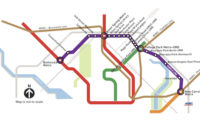Maryland’s troubled $2-billion Purple Line light rail project will move forward with a smaller concession team and no clarity on its design-builders. This follows a $250-million agreement between its private developer and state transportation agencies that settles a lengthy cost dispute and cements the exit of Fluor Corp. from the project as both financial stakeholder and constructor.
Announced Nov. 24, the deal settles all outstanding claims and terminates litigation between the Maryland Dept. of Transportation and Purple Line Transit Partners (PLTP)—made up of Meridiam, Star America and Fluor—arising from multiple delay issues that have resulted in approximately $800 million in cost overruns and added nearly two years to a project originally set for completion in 2022.
The agreement "is a major step forward toward completing the Purple Line," said Maryland Gov. Larry Hogan (R).
The settlement also sets the stage for PLTP to resume overseeing construction of the 16-mile, 22-station Purple Line across two dense counties in suburban Washington, D.C., with Meridiam and Star America to initiate a solicitation for a new design-build contractor.
Details Still to Come
The timeline for that process and other agreement details, such as private financing for an estimated $900 million in project costs, will not be announced until after its review next month by the state’s Board of Public Works, made up of Hogan, state Comptroller Peter Franchot and state Treasurer Nancy Kopp.
Jane Garvey, Meridiam chairwoman and head of the PLTP board, noted a "resilient partnership" with the state, despite months of "challenging but always good faith negotiations."
Settlement allocation among the project firms was not made public, but an industry executive with project knowledge said that, assuming the bulk goes to Fluor, "actual out of pocket costs would be covered, but not costs for delay and profit is gone."
Fluor did not comment on the settlement.
PLTP’s long-running legal dispute with state agencies led the consortium to formally withdrew from its 36-year design, build, operation and maintenance concession in September, a move that was a Maryland circuit court judge subsequently upheld. The agencies have since managed a scaled-back construction effort while negotiations with PLTP continued.
Cost and delay issues related to lawsuits and late right-of-way designation by agencies had been close to settlement late last year, according to project officials, but other growing future expenses include changed design parameters for an adjacent freight-line crash wall and altered environmental permit mandates.
MDOT has explored other options for continuing the Purple Line, either as a public-private partnership or via another delivery method. The agency publicly asserted that it had received expressions of interest from potential contractors, although no firms were named.
It is not clear which, if any, of Fluor's design-build partners will remain. They include Lane Construction Corp., Traylor Brothers Construction, and key subcontractors Hensel Phelps and MC Dean, as well as lead design firm Atkins, now a part of SNC Lavalin, and subconsultant Mott McDonald.
Firms that were part of other short-listed P3 teams for the project more than five years ago include Vinci Concessions S.A.S., Walsh Investors LLC, Kiewit Development Co., Edgemoor Infrastructure & Real Estate LLC. and Skanska Infrastructure Development Inc.
"I will assume it will be lump-sum as the original contract was," says one industry source with knowledge of the project. "This may be a tough sell in the current environment."
Risk Reduction?
According to the agreement with PLTP, the Maryland DOT and Maryland Transportation Administration will continue managing contracts for bridge work, stormwater drainage, paving, utility and pump station construction and manufacture of light-rail vehicles until a new design-build team is on board.
An MDOT statement adds that the agencies will focus on “reducing risks in the upcoming solicitation by completing design, acquiring permits and advancing utility work along the Purple Line corridor.”
But some project observers note that questions remain on current ownership of Purple Line designs and other project "intellectual property" by Fluor, Purple Line Transit Partners or Maryland, and how that affects a new design-build team. "If I am a design-build firm, do I pick up someone else's design and liability?" asks one observer.
Completion of the Purple Line is considered a priority for Maryland Gov. Hogan (R). "Hogan wanted to clean it up," says one industry executive with knowledge of project participants. "He doesn't want a big claim out there."
In a statement, Hogan praised state Secretary of Transportation Greg Slater and PLTP “for coming together to find a path forward that will lead to a new contractor.”
Hogan is also backing a proposed $11-billion P3 for adding express lanes to portions of the heavily traveled I-495 Capital Beltway and I-270 in Montgomery County.
But some market observers have questioned financial risks for the approach raised by the lengthy Purple Line dispute, according to a recent Bond Buyer report.
Concerns about the P3 approach due to the Purple Line experience and effects on air and water quality and historical sites, among other issues, are raised in about 3,000 comments from environmental group, local governments and planning agencies, and even the U.S. Navy, filed in response to the widening project's draft environmental impact statement, in a 120-day comment period that ended on Nov. 9, which could portend future delaying legal challenges to the project.
The state transportation department is "planning measures to address litigation risks," a spokesman told The Washington Post on Nov. 27.







Post a comment to this article
Report Abusive Comment